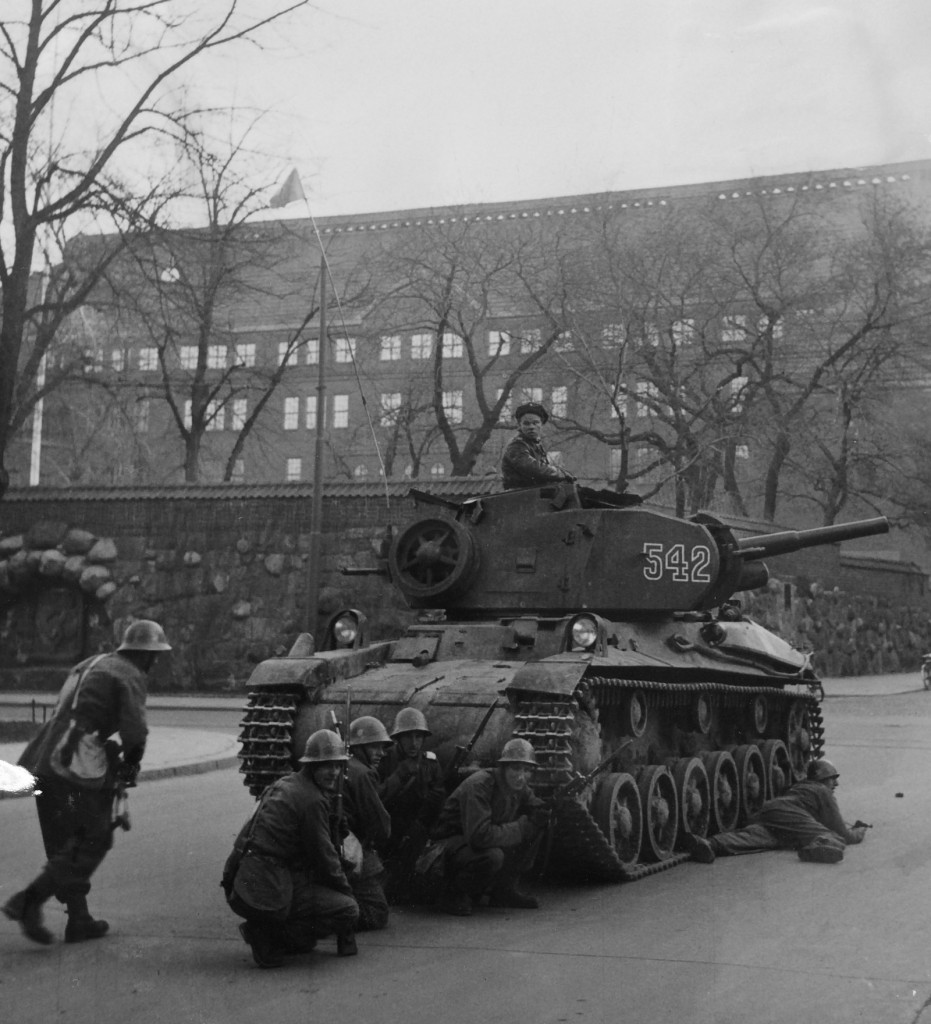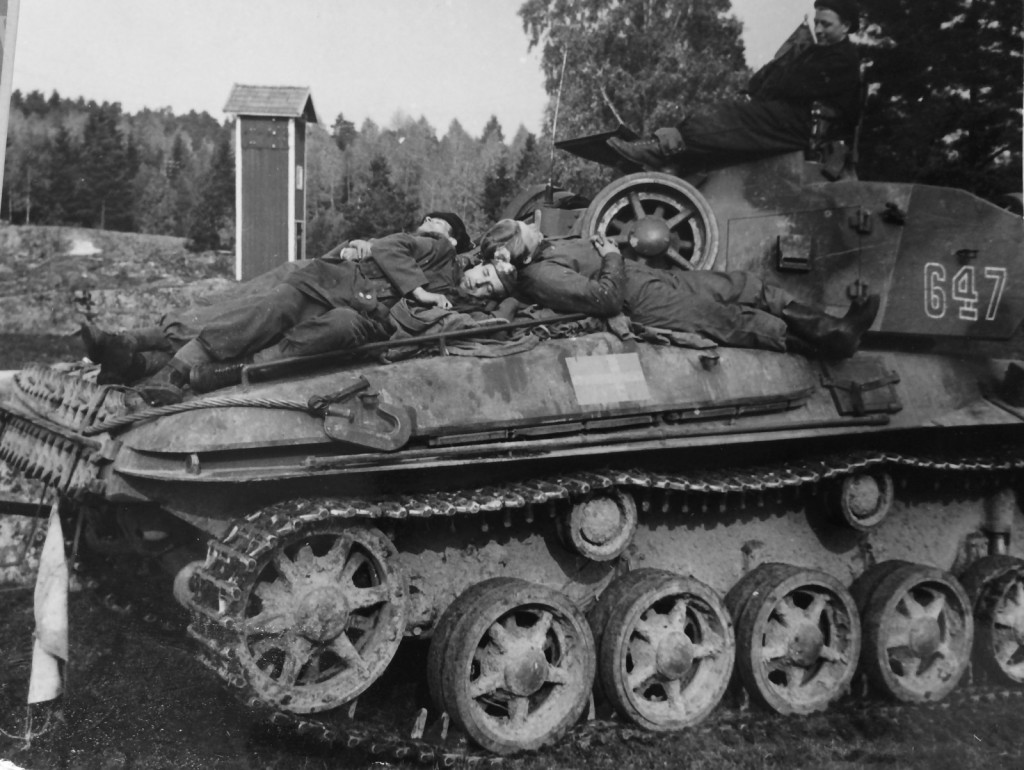Posts Tagged: strv m/42
Stridsvagn m/42 on an urban combat exercise, 1944
Stridsvagn m/42 on an urban combat exercise in the streets of Östermalm, Stockholm, April 29th, 1944.
List of Landsverk tanks as of April 1949
A letter from Landsverk to KAFT (dated 1949-04-09), containing data and drawings of some of the then-modern tanks produced there, as well as proposed data and drawings for a number of planned tanks developed by the company at their own expense.
It may be worth mentioning that most of the tanks have “motyl 25” listed as their fuel. Motyl 25 is a mixture of ethanol (that is to say, alcohol) and regular gasoline in the proportions 25% ethanol and 75% gasoline. During WW2 this was used extensively to help offset the Swedish oil shortages, but in those times both motyl 50 (50% ethanol) and motyl 75 (75% ethanol) were common. Today, we see the same thing in the form of the commercial E85 fuel available at many gas stations.
The reason this is in an archive volume dated 1948 is that apparently the same list was sent over in September that year, but KAFT seems to have misplaced some pages so it was sent over again and apparently the bureaucracy found it appropriate to place both the letter and the complete list together with the original list. Most of the pages are present twice in the archive volume.
Archive reference: SE/KrA/0062/D/01/016:H/F I/15
Memo regarding guidelines for new AFV development (1944)
Original title: VPM med förslag till riktlinjer för planering och utprövning av nya stridsvagnar mm.
This memo (dated 1944-11-29) suggests guidelines for future AFV development. It starts off with discussing foreign developments, and states that the general opinion seems to be that anti-tank weapons have reached such a degree of efficiency that merely building more heavily armored tanks no longer seems cost-efficient. At the same time, the demand for “support tanks” (self-propelled guns and tank destroyers) is on the rise.
With this in mind, the memo suggests a number of new developments, mostly improvements of existing designs, and suggests that using the new “split” turret with an automatic gun rammer (currently under development at Bofors) might be a good idea.
Archive reference: SE/KrA/0062/D/01/016:H/F I/4
Minutes of meeting (1941-04-30) regarding development of new AFV’s
Original title: Sammanträde ang. strv m.m. å MB3 den 30 april 1941
This document contains minutes of a meeting held on 1941-04-30, where the requirements for a new tank and/or tank destroyer are discussed. The decisions made at this meeting led to the development of the strv m/42.
The meeting starts off with an overview of the tanks currently available to the Swedish army (48 strv m/37, 16 strv m/38 and 20 strv m/39), as well as the ones ordered but not yet delivered (100 strv m/40 to be delivered before the end of 1941 and 116 license-built TNH with deliveries starting summer 1942). The meeting participants conclude that neither current tanks nor current towed anti-tank guns (mostly 37 mm Bofors) are sufficient to fight modern German or Russian tanks, and that it is necessary to develop either a new, heavier tank or a self-propelled anti-tank gun of some kind, and quick.
Three current Swedish tank development alternatives are presented: the Landsverk Lago (originally intended for Hungary), the Landsverk Terro (a 14 ton tank with a 57mm gun and 50 mm frontal armor) and an unnamed design proposal for a 22 ton tank with a 75mm gun and about 70mm frontal armor.
Weight restrictions are brought up. If strategic mobility is disregarded, tanks suited to Swedish terrain should weigh max 30 tons, but since tanks have to move along roads and over bridges, the meeting concludes that a new AFV (tank or TD) must not weigh more than abut 20 tons in order to retain sufficient strategic mobility.
Some discussion follows, with several different proposals from the meeting participants. Someone proposes a 20 ton TD with a 75mm gun and 70mm front armor, but is met with opposition and the counter-argument that Swedish terrain is better suited to more mobile anti-tank guns, and that the Swedish military attache in Berlin reports that tanks are the best weapon for fighting tanks. Someone else then proposes an 18 tank with a 105mm short-barreled howitzer, but this idea is not received favorably since both the precision and the rate of fire would be low.
In the end the meeting decides that development should focus on a 20 ton tank with 60 mm of frontal armor and armed with a 57mm gun (or alternatively a 75mm or 105mm gun), with a max speed of 40 km/h.
Archive reference: SE/KrA/0062/D/01/016:H/F I/1 a
Minutes of meetings regarding a better gun for strv m/42
Minutes from three 1944 meetings, regarding equipping the strv m/42 with a better gun. The existing 7,5 cm kan m/41 strv has insufficient penetration, and a replacement is clearly necessary considering the tank development seen so far during the war. A 57 mm option is considered, but in the end it is decided to let Bofors fit the 75 mm pvkan m/43 for trials.
This requires a redesigned turret; blueprints for that are attached. These presented my small camera with some problems since they’re huge (they portray the entire tank – 6.2 meters long in reality – at scale 1:5, which means the tank is about 1.2 meters long on the blueprint) so I’ve had to photograph them in parts.
Archive reference: SE/KrA/0062/D/01/016:H/F I/3
Minutes of meetings with the armor committee of 1941
The “armor committee of 1941” (1941 års pansarkommitté) was a working group tasked to develop a satisfactory Swedish medium tank, with severe time constraints and a strict requirement that it must not weigh more than 22 tons. The result was strv m/42, which basically was an improved Landsverk L-60.
These four documents contain minutes of meetings with the committee in 1941 and 1942.
Archive reference: SE/KrA/0062/D/01/016:H/F I/1 a
Orientation regarding current projects (may 1954)
Minutes from a meeting (1954-05-04) at the arms administration’s vehicle bureau regarding the status of current projects. Mentions the “tankette” (project 6400 aka. the KRV), kv 155 (a SPG prototype that would eventually become akv 151 and then eventually bkan 1), lvkv fm/49 (a SPAAG) and the upgunning of strv m/42.
Archive reference: SE/KrA/0266/002/01:H/F I/1
Meeting minutes re: upgunning strv m/42
Minutes from a meeting at Landsverk 1952-02-15 where different turret options for strv m/42 were discussed.
Archive reference: SE/KrA/0266/002/01:H/F I/1
Alternatives for upgunning strv m/42
Memo dated 1954-02-17 regarding options for upgunning strv m/42. Mentions both an oscillating turret and rebuilding as a tank destroyer.
Archive reference: SE/KrA/0266/002/01:H/F I/1


